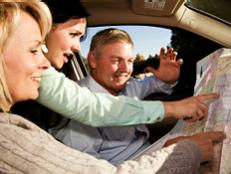Tips for Taking Your Dog on a Road Trip
National Dog Day is August 26; here are some important reminders on how to travel safely with your beloved fur baby.

SolStock
If you and your family – four-legged members included – plan on taking an end-of-summer trip, make sure you’ve got what you need to ensure the trip is comfortable for your pet.
3 Reasons to Make a Trip to the Vet First
Reason one: Make sure your dog is up-to-date on their vaccines and flea treatments. You don’t want worry about if his rabies shot is still good after he has an accidental skirmish with some wildlife, or in case he meets up with a sick pup at a rest stop. Reason two: Get an extra copy of those immunization records and bring them with you. In case your pooch does get sick, you’ll be ready if you have to visit another vet while away from home. Also, if you plan on camping, many state parks require proof of immunizations in order to stay there. Reason three: If it’s your pet is prone to car sickness, you can pick up some anti-nausea medicine.

Alison Turner
Get Them Use to the Car
If your dog isn’t a frequent traveler, get him use to the backseat by making small trips around the neighborhood or to the dog park. Dr. Jason Nicholas, president and Chief Medical Officer of PreventiveVet.com, suggests making time for some pre-trip games in the car: "With the car turned off, just take their favorite toy and throw it in the car and let them get it. Then, give them a treat when they get out." He suggests doing that for a few minutes every day for a few days leading up to the trip. "You just want them to start seeing the car as a fun thing, because it should be."

Buckle Up
Pets love fresh air, and we all giggle a little at the sight of a furry face and sloppy tongue drooling out the window. But don’t do it. Buy a harness or carrier that can be belted in, or a crate and have your dogs seated in the backseat or cargo area. This will keep them and you safe. Dr. Nicholas says it's the safest place for your pet. "Unrestrained dogs are a huge, huge safety risk."

cmannphoto
Tag + Chips
Before you set out, make sure your pooch's microchip is up to date (if you haven't gotten your little one chipped, do that ASAP.) Also, get an additional tag for the trip, one that has your cell phone number and perhaps a friend or family member in the area you're visiting.

DogVacay.com
Pack Their Suitcase
It’ll make your life easier if you keep all of your pet’s needs in one bag. Including food, toys, poop bags, brush, treats, as well as their favorite bed or blanket. Having familiar items like their favorite blanket or nap rug will help comfort your pet if the trip becomes stressful.
Don’t Forget Your Pet’s First-Aid Kit
Add a few things to your human first-aid kit to make it pet-ready. Autotrader.com suggests you stock it with an ACE bandage, blood-clotting powder (ClotIt is a favorite of vets), a flea comb and tick remover, Benadryl, a bottle of saline eye rinse and tweezers and gauze. Download the American Red Cross's Pet First Aid app, it gives suggestions on what to do in a number of common pet emergency situations, and includes a list of veterinary medical providers across the United States.

studioportosabbia
Know the Weather
Your dog can get overheated fast in summer months, faster than you do. It’s important to keep them cool and supply them more water than you think is necessary. And obviously, don’t leave your pet in a hot car. For winter months, remember to bring extra blankets and doggie sweaters.

Alison Turner
Get Out of the Car, Often
Traveling with a pet means you are not going to make your land-speed record to your destination. Don’t even think of it. Your dog needs time to get out and stretch their legs. Experts suggest a 15- to 30-minute break every four hours. Having a routine is important to your pet. So, try to keep to your regular walking times and feeding times. If your dog is a social creature, there are several free apps out there that will help you find dog parks along your route.
Make Sure Pets Are Allowed
More often than not, dogs are not allowed at national and state parks. Do your research so you won’t be disappointed about the restrictions when you get there. National forests and the Bureau of Land Management (BLM) properties are more likely to allow pets. You can find out via their website at www.BLM.gov.




























.jpg.rend.hgtvcom.231.174.suffix/1674758726773.jpeg)










